
Bitter melon or bitter gourd, popularly known locally as the lowly “ampalaya plant and fruit” have been discovered to cause cell death in four lines of pancreatic cancer cells. Also observed to prevent the growth of pancreatic cancer tumors (ductal adenocarcinoma of the pancreas) among laboratory mice.
A Studies About Bitter Melon
The study conducted on Bitter Melon Juice (BMJ) by researchers of the University of California at San Diego in 2013 and published in the journal Carcinogenesis proved that the research, testing and application of ampalaya (bitter melon) in our herbal remedies have a scientific basis.
Scientifically called Momordica Charantia (MC), ampalaya has also been called “bitter gourd, bitter squash, goya (in Japan), and karavella.” This fruit found and grown extensively in Asia and the Subcontinent, Africa, the Caribbean including New Zealand happens to have a bitter taste, hence called “bitter gourd”. It is usually mixed in soups and with other vegetables in casserole dishes to temper the bitterness. Vegetables and fruit extracts are used as tea as well.
Almost all parts of the ampalaya plant are consumed. From leaves, stem, flowers and fruit except for the seeds ̶ both as vegetables, traditional folk medicine and now, naturopathy and homeopathy. Ampalaya is both grown, eaten and used for medicinal purposes in India and China for thousands of years.
Fights Against Diseases
Some of the medical conditions and diseases that ampalaya has successfully been tested to treat, aside from pancreatic cancer are the following:
- Inhibits the growth of breast cancer cells.
- It works as an anti-malarial agent.
- Can work as an antibiotic.
- Fights against parasitic worms.
- Contains substances which reduce diabetes mellitus.
- Has potential curative properties for skin cancer, prostate cancer, liver cancer, etc.
- Traditionally, it has been used as a laxative, anti-ulcer, anti-helminthic and anti-malarial cure. It was also used as an anti-malarial concoction, as a defense against respiratory diseases, rheumatism, and AIDS.
- Tested for treating leukemia, specifically an extract from ampalaya that inhibits the soluble guanylate cyclase from affecting leukemia cells.
Nutritionally, ampalaya has a wide variety of nutrients, specifically carbohydrates, fiber, proteins, vitamins and minerals. Studies show that ampalaya contains the highest nutritive value of Vitamin C with the Chinese version of ampalaya containing 440-780 mg. of Vitamin C per edible portion. It also has minerals like calcium, iron, zinc, phosphorous, magnesium and ascorbic acid. zinc, iron, calcium, magnesium, and phosphorous.
Its raw protein content is 11.4–20.9 g·kg, higher than that of tomato and cucumber.
What now Bitter Melon?
Several pharmacological studies are still being conducted to have a clearer view of ampalaya’s anti-cancer attributes. Personally, I would like to have a lot more healing establishments using the lowly ampalayas as a panacea for debilitating diseases. Based on our experience, ampalaya really works! I hope a lot more people will use it as a staple in their daily diet.
Copyright 2024, DoctorFarrah.com








